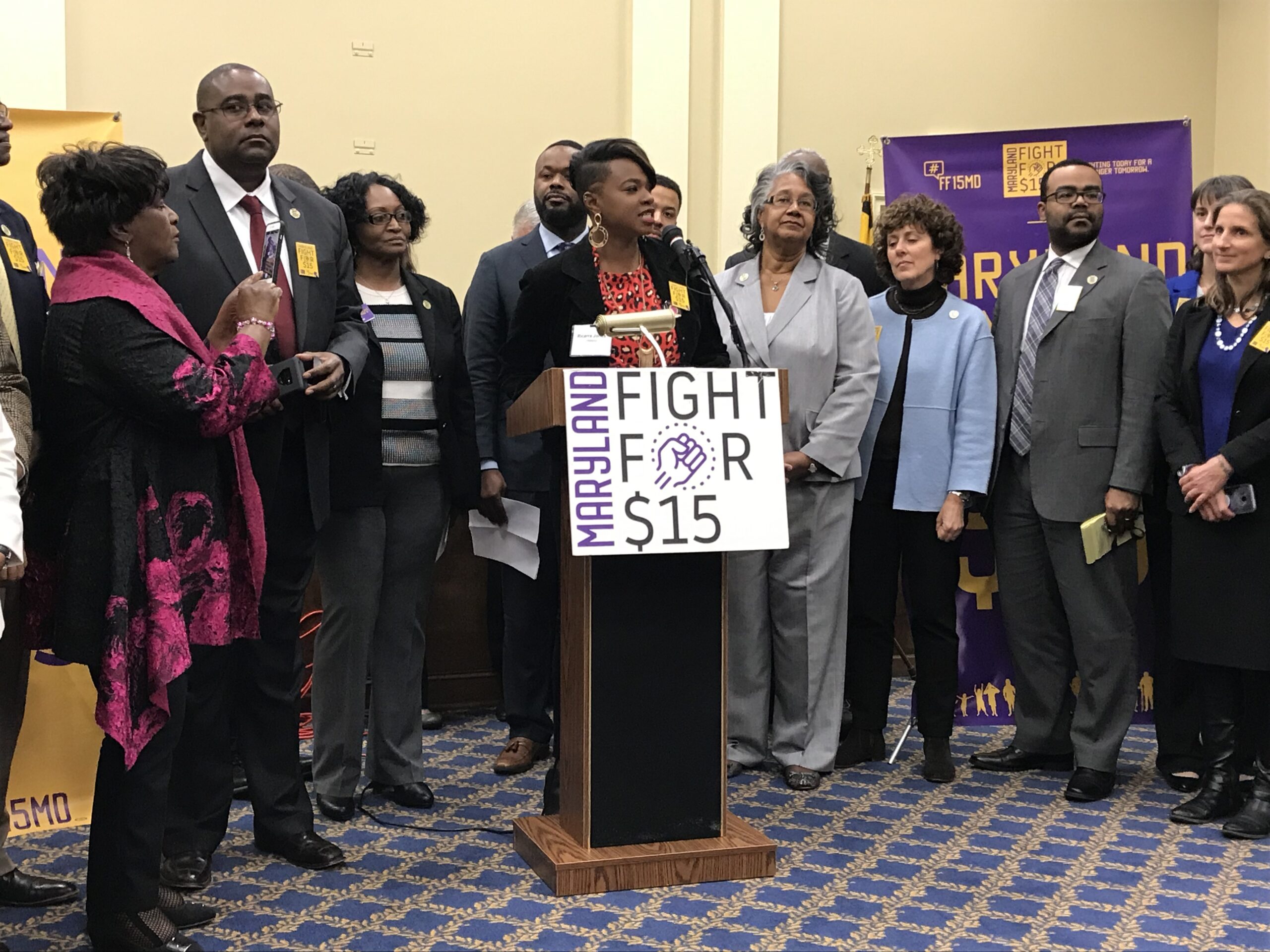There’s No Wage Like the Minimum Wage

Sixth in a series
On March 27, 2019 Maryland faced financial Armageddon.
It was a situation so dire that Gov. Lawrence J. Hogan Jr. (R) warned legislators that the state’s economy would soon be “devastated.” Thousands would be thrown out of work as costs spiraled out of control. Only immediate action would stave off the crisis.
The disaster Hogan saw looming was a bill the legislature had approved that would gradually raise the minimum wage from $10.10 to $15 per hour by 2025.
As disasters go, it qualifies as a Bigfoot: often rumored but never confirmed.

However, in Hogan’s defense, he was upholding the classical economic theory that when prices rise demand drops. If businesses were forced to pay more to their workers, the classical model says they would have to lay off some of their workforce to remain competitive. Or, alternatively, they could raise their prices. But that would put them at a competitive disadvantage with nearby states like Virginia, which has a $7.25 minimum wage. Disaster ensues.
But is the classical theory accurate?
When it comes to child hunger, it is a key question. Raise the minimum wage and people will have more money to buy food. This is especially true in Maryland, where the current minimum wage of $11 means a person would earn $22,880 a year. That is far below the $60,000 that MIT has said a family of one child and one parent would need to survive in Anne Arundel County.
And, as disasters go, it is Maryland’s reluctance to substantially raise its minimum wage that seems more pressing. In places like Anne Arundel County there has been a sharp rise in the number of children eligible for free school lunches over the last decade.
It was precisely the question of the minimum wage that interested David Card and Alan Krueger, two Princeton University economists, in the early 1990s.
On April 1, 1992 the New Jersey legislature did something that appeared to be pretty unremarkable at the time: it raised the state minimum wage from $4.25 to $5.05 per hour.
What Krueger and Card realized was that New Jersey had set up the perfect natural experiment in economics. While New Jersey had raised its minimum wage, the adjoining state of Pennsylvania had not. Its minimum wage was still $4.25.
If the classical theory was correct, unemployment would go up in New Jersey where labor costs had risen and, conversely, businesses would move to Pennsylvania to take advantage of the lower minimum wage there. In other words, New Jersey would be the test group and Pennsylvania the control group.
Before the minimum wage hike took place, the two men started collecting data on employment, wages and prices at 410 fast food restaurants in Pennsylvania and New Jersey. And after the increase they revisited the same restaurants to see what happened.
Much to the researchers’ surprise, employment didn’t drop in New Jersey. In fact, it went up slightly.
“Contrary to the central prediction of the textbook model … we find no evidence that the rise in New Jersey’s minimum wage reduced employment at fast-food restaurants in the state,” the professors concluded.
That would seem to have settled the question. But as one anonymous wag once noted, “If all the economists were laid end to end, they would never reach a conclusion.” And, indeed, subsequent studies have both confirmed and disputed the 1993 paper.
A paper by three researchers at the University of British Columbia said that if the Princeton economists had followed labor trends a bit longer, they would have eventually seen minimum wage workers losing their jobs. On the other hand, a study by four economists who investigated 139 minimum wage hikes over a nearly 40-year period argued that Krueger and Card were right.
And so, the debate continues.
That was why at a February 2019 hearing in Annapolis, Pat McElroy, vice president of Tim’s Automotive Services in Baltimore County, warned, “Our employees suffer if the minimum wage goes up. People in Maryland suffer. We have been in business for 31 years. We’re Marylanders. We aren’t moving. But our employees are victims themselves.”
McElroy’s argument is not new. In fact, it is eerily similar to what was said in another debate a century earlier, over child labor.
In 1916, while Congress debated a bill to restrict child labor, Rep. J. J. Britt (R) of North Carolina said he opposed the bill in part because, “it would take the children’s jobs away and ruin their chances of becoming useful citizens by throwing them out on the streets to loaf.” At the time, children as young as 12 were working 10-hour shifts in textile mills.
The same refrain is also heard when Randy Hargrove, the official Walmart spokesman, tries to defend his company’s low wages. Walmart is actually mentoring its employees, Hargrove says. “It’s not where you start. It’s where you end up. It’s the opportunities you have. Beyond anything else, we offer opportunity.”
And Hargrove’s argument echoes that of former North Carolina Gov. William W. Kitchin (D) in 1916. Kitchin defended child labor saying, “There are orphans, children of widows, and dependents who must work in order to live. A cotton mill pays him more wages than he can get anywhere else in the South … he lives in a better home, has better clothing and better food in 99 cases out of 100 than he had before his parents came to the mill.”
Child labor offers opportunity!
These arguments all use the same trope. Whether defending a 12-year old working 10 hours a day in a factory or paying a worker a salary he can’t possibly live on, it is all being done in the best interests of the person being exploited.
The net result of the political debate at the national level is gridlock. While 29 states have increased their minimum wage, the federal minimum wage is stuck at $7.25 and it has been stuck there since 2009.
The truth may be that the political debate over the minimum wage may not be moored to any kind of reality.
Opponents of any minimum wage increase ignore at the very least such things as inflation and productivity growth. If $7.25 was acceptable in 2009, why would it be a disaster to at least increase it by the rate of inflation?
There has also been productivity growth over the decade. A person who was able to produce one widget in 2009 is now able to produce three widgets thanks to technological innovations. Why shouldn’t workers share in this increased productivity?
This is precisely the argument of Benjamin Orr, executive director of the Maryland Center on Economic Policy. “For much of our history wages and productivity moved in tandem. Then in the 1970s, we saw it divide,” Orr said. “When you look at where our minimum wage would be if we had kept pace with productivity and accounting for inflation, it’s much higher than any of the proposals out there. As of last year, it would be $20.34.”
Those on the other side of the debate have seized on the idea that $15 per hour is a living wage. When the cry for a $15 minimum wage first went up seven years ago in New York City, it came from disgruntled workers in the city’s fast food restaurants. “Many of these workers have to rely on government assistance because they’re being paid poverty wages,” one of the protestors explained.
Now the rallying cry for those who want to raise the minimum wage is $15 an hour.
But that claim runs headlong into the broken yardsticks we use to measure what a living wage is. A $15 minimum wage works out to be $31,200 per year. If we use the federal threshold of $12,490, the person seems to have experienced a windfall.
But the federal measure of poverty is so discredited that, when calculating federal benefits, government typically bumps up that number. For example, to be eligible for food stamps in Maryland you can earn up to 130% of the federal poverty level.
The $15 figure also does not consider how many people must depend on that paycheck. The MIT Living Wage calculator says that if the wage earner has one child, the living wage in Anne Arundel County is $60,000. But add a few more children to the equation and now the MIT calculator says the family income must be over $80,000 to stave off poverty.
“I believe in Maryland there is no jurisdiction in the state where the minimum wage is enough to support a family of four,” said Orr. “People think about the minimum wage as a kind of starter job for high school students. In fact, who makes the minimum wage has changed dramatically in the last 50 years. These are career tracks that people get stuck on at minimum wage or close to minimum wage level.”
If raising the minimum wage is not a panacea, the legislature decided it is also not an impending disaster. The day after the governor vetoed the increase, the legislature overrode the veto.
We now await the arrival of Bigfoot.
Read the whole series:
Part one: Meet the Food Stamp Firms of Maryland, plus Bum Blockade: How We Got the Food Stamp Data
Part two: All About the Hunger Industry, plus The Tax Deduction Recipe That Feeds Hunger
Part three: Measuring Hunger: One Size Does Not Fit All, plus Calculating How to Go Hungry
Part four: The No Man’s Land of Childhood Hunger
Part five: When the Floor Becomes the Ceiling
Part seven: The Volunteer Army Trying to Fight Hunger
***
Enjoy reading Maryland Matters?
Get our morning news roundup in your inbox. Free.
Click here to sign up.



 Creative Commons Attribution
Creative Commons Attribution